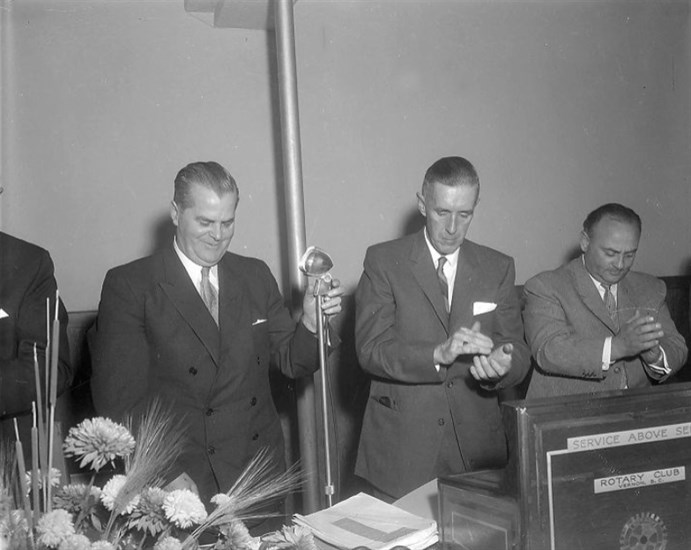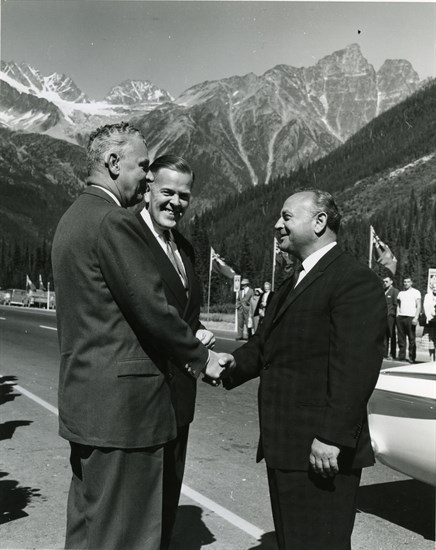
From left to right, Premier W.A.C. Bennett, Vernon Board of Trade President A.J. Gilroy and Highways Minister Phil Gaglardi at a Vernon Board of Trade luncheon in 1958.
Image Credit: Submitted/Vernon Museum and Archives
December 17, 2023 - 6:00 AM
While they were each dubbed with quirky monikers, two men from Kelowna and Kamloops came to power through a strange electoral process in 1952 that transformed the province.
W.A.C. (Wacky) Bennett was a teetotaling hardware store owner who became premier of BC in that year while (Flying) Phil Gaglardi was a Pentecostal minister from Kamloops who became his Minister of Highways.
But it was a misguided effort of a failing Liberal-Conservative coalition that brought both men to office and shifted the power centre away from the Lower Mainland and Victoria.
“All of a sudden, we get these Socreds,” historian and former politician David Mitchell told iNFOnews.ca. “Most of them came from the Interior – W.A.C. Bennett and Phil Gaglardi among them – and they had a different view of the province. They wanted to open it up. Bennett had a vision in particular. He wanted to really open it up, building dams, bridges and highways and having a Minister of Highways from the Interior, from Kamloops, was beneficial.”
Bennett had been involved in politics since first being elected as a Conservative in 1941. The Liberal-Conservative coalition was formed following that election.
After failing to win his party’s leadership in 1951, Bennett left the Conservatives, sat briefly as an independent, then joined the Social Credit Party that had been in power in Alberta since the 1930s but had never elected an MLA in BC.
Bennett gave the Socreds instant credibility but, because some worried that this Conservative was taking over the grassroots Social Credit party, the party chose to fight the 1952 election without a leader.
The Liberal-Conservative coalition, at that time, feared the CCF (forerunner to the NDP) would take power so they put in a “single transferable vote” system where voters ticked off their second, third and fourth choices.
That may not have affected the election outcome for the popular WAC Bennett but it was a different story for Gaglardi in Kamloops.
“Phil Gaglardi was persuaded to run in Kamloops,” Mitchell, who is the author of the book: ‘W.A.C. and The Rise of British Columbia,’ said. “He didn’t have a large following. In a first-past-the-post system, he would have been third or fourth.”
It took a month for the complicated ballots to be counted and, to many people’s surprise, the Socreds finished first but with only 19 of 48 seats, with the CCF getting 18. By gaining the support of an independent, the Social Credit party was able to form a minority government.
Those 19 MLAs cast their ballots for their leader.
“Of the 19 votes, W.A.C. Bennett received 14 or 15,” Mitchell said. “There was a sworn affidavit by the scrutineer, a long time Socred, to testify to this because of some claims that were clearly lies and Phil Gaglardi was responsible for spreading one significant lie that he lost by one vote. In fact, he only got one vote, his own.”
READ MORE: Highway 3 was BC’s first trans-provincial highway despite reverting back to nature
In 1953, Bennett orchestrated a non-confidence vote in order to force a new election, in which he won a majority. He quickly scrapped the single transferable vote system.
That first, somewhat contentious, leadership vote was the start of a 20-year relationship between the two men that was often strained, to say the least.
It culminated in comments attributed to Gaglardi that, some say, were a major reason the Socreds were defeated by Dave Barrett and the NDP in 1972.
Bennett, according to Mitchell, was the driving force behind change in BC.
“He had a vision of provincial development – including the Interior and the North – that we’d never seen in British Columbia before because it had always been the Lower Mainland and Southern Vancouver Island that was the focus of development,” he said. “It never much went beyond that.
“He was considered to be a right-wing populist but he was extraordinary for using the provincial government aggressively as an agent of development by creating all these crown corporations, BC Ferries, BC Rail, BC Hydro. He did all that at the time he was considered to be the right leaning premier of the province. In fact, the CCF, and later the NDP, were often very jealous of what he was doing because it had sometimes been what they had been proposing.”
READ MORE: How an Indigenous trail through Kicking Horse Canyon grew into a super highway
Through much of it, Bennett relied on Gaglardi to get things done, initially appointing him as Minister of Public Works then as the province’s first Minister of Highways.
“He (Gaglardi) contributed to the rise of British Columbia by being an amazing highways minister,” Mitchell said. “He built more roads and paved more highways than anyone has since. But, he was also increasingly an embarrassment to the Socreds and the government and damage control was the order of the day.”

Ceremony to mark completion of the Trans Canada Highway at Rogers Pass, September 3, 1962. Three men shaking hands (left to right): Prime Minister John Diefenbaker, M.P. Davie Fulton, B.C. Minister of Transportation Phil Gaglardi.
Image Credit: Submitted/Revelstoke Museum and Archives
Even Gaglardi’s supporters acknowledge that he did get into trouble a lot.
"People either think Phil Gaglardi is the world's biggest crook or a saint. The truth is somewhere in between," Mel Rothenburger, former editor of the Kamloops Daily News, mayor of Kamloops and author of a biography of Gaglardi called ‘Friend O' Mine,’ is quoted as saying in an ABC Bookworld review.
Neither Rothenburger, nor anyone from Gaglardi’s son’s Northland Properties, responded to requests for an interview.
“Bennett was very loyal to all his ministers, even when they got into trouble, and Gaglardi got into trouble a lot,” Mitchell said. “He was constantly getting into mini-scandals and controversies and caught lying about what he was doing, what his family was doing.
“His sons were accused, more than once, of land speculation along routes where highways were going to get built before it was known they were going to get built. These kinds of scandals came up time and again in the legislature and Bennett had to manage this because Gaglardi was constantly getting into trouble.”
Not the least of his “troubles” was repeatedly getting speeding tickets.
“When he was highways minister, Phil Gaglardi had powerful cars with V8 engines parked at several places along highways he was building and, when he would get driven there, he would get in the car and he wanted to drive it.
“These cars were maintained by highways staff and they had powerful air conditioning units. They weren’t used most of the time but the staff, who kept them well maintained, used them with the air conditioners to keep their beer cold when the weren’t being used, which was most of the time.
“But, when they were being used, Phil Gaglardi would always get speeding tickets. His famous riposte was: ‘I wasn’t driving too fast. I was just flying a little too low.’ He used to joke and try to make fun of all these tickets he got but that’s where he got the nickname of Flying Phil Gaglardi.”
READ MORE: The true story of Grand Chief Nicola, told by his descendant
It was his family’s use of the province’s Lear jet that led to his downfall after his daughter-in-law caught a free flight to a wedding in Texas (the jet was going part way there for repairs in Wichita, Kansas).
“When W.A.C. Bennett confronted Gaglardi about this, and Bennett had the information a little wrong, he said: ‘Phil, I understand you flew your daughter in the government jet. You know that’s not allowed,’” Mitchell said. “Well, Gaglardi denied it because, in fact, it wasn’t his daughter. It was his daughter-in-law and that’s how he got through this one by promising to his boss that he didn’t fly his daughter.”
Still, it led to him being ousted from cabinet.
Just how that ousting happened is controversial.
Newspaper reports at the time in 1968 had Bennett saying Gaglardi resigned for health reasons and Gaglardi saying he resigned because the government was being damaged by the constant attacks on him.
It later came out that Bennett had actually fired Gaglardi, Mitchell said.
“It was a hard thing for Bennett to do because Bennett was so unfailingly loyal. It was very emotional. He had to fire Phil because he was caught just one too many times with his hand in the cookie jar, so to speak.”
READ MORE: IN PHOTOS: Where to find abandoned flumes in Kamloops and the Okanagan
In 1969, the Socreds won the biggest majority in BC history and Bennett named Gaglardi as Minister of Rehabilitation Social Improvement.
“Phil Gaglardi got into more problems by saying, 'we’re going to kick all these deadbeats off the welfare rolls' and all this stuff that Bennett didn’t feel comfortable with,” Mitchell said.
The final straw came just five days before the 1972 election when a newspaper reported that Gaglardi claimed Bennett was too old, was out of touch and was only staying on to block Gaglardi from the leadership.
“When confronted with the political fallout generated by his intemperate and self-serving comments, Gaglardi denied responsibility, calling the story trash and claiming he had never said any such thing about Bennett,” Della Roussin wrote in her 2012 Masters Thesis for UBC called ‘Political Legitimacy and Regime Change: The 1972 BC Election.’
“Dave Barrett recalled the episode as ‘probably the single most influential event of the campaign. It directed the spotlight not only on a pending leadership struggle within the party ranks but also on the Socred politician most often tainted with scandal.’”
While the long-serving Social Credit government was also facing pressure from the BC Teachers’ Federation actively campaigning against them along with widespread labour strife, Roussin suggested that, with no other successors likely, voters just couldn’t stomach the possibility of Gaglardi becoming an unelected premier.
Whether he was guilty of multiple lies or not is, to a certain extent, in the eyes of the (historian) beholder.
“Gaglardi made a famous statement,” Mitchell recalled. “He said: ‘You know, if I’m lying, it’s only because I think I’m telling the truth.’”
That’s not quite how the ABC Bookworld review quotes Gaglardi speaking in the Legislature: “’Mr. Speaker,’” it wrote, “’You know, if I’m telling a lie, it’s only because I’m telling the truth.’”
Regardless of just how he phrased his defence, and despite all the controversy, the two men did shift the power balance in the province and opened up the Interior of BC with roads, bridges (including the first Okanagan Lake bridge that opened in 1958), railroads and all the economic development they sparked.
To contact a reporter for this story, email Rob Munro or call 250-808-0143 or email the editor. You can also submit photos, videos or news tips to the newsroom and be entered to win a monthly prize draw.
We welcome your comments and opinions on our stories but play nice. We won't censor or delete comments unless they contain off-topic statements or links, unnecessary vulgarity, false facts, spam or obviously fake profiles. If you have any concerns about what you see in comments, email the editor in the link above. SUBSCRIBE to our awesome newsletter here.
News from © iNFOnews, 2023